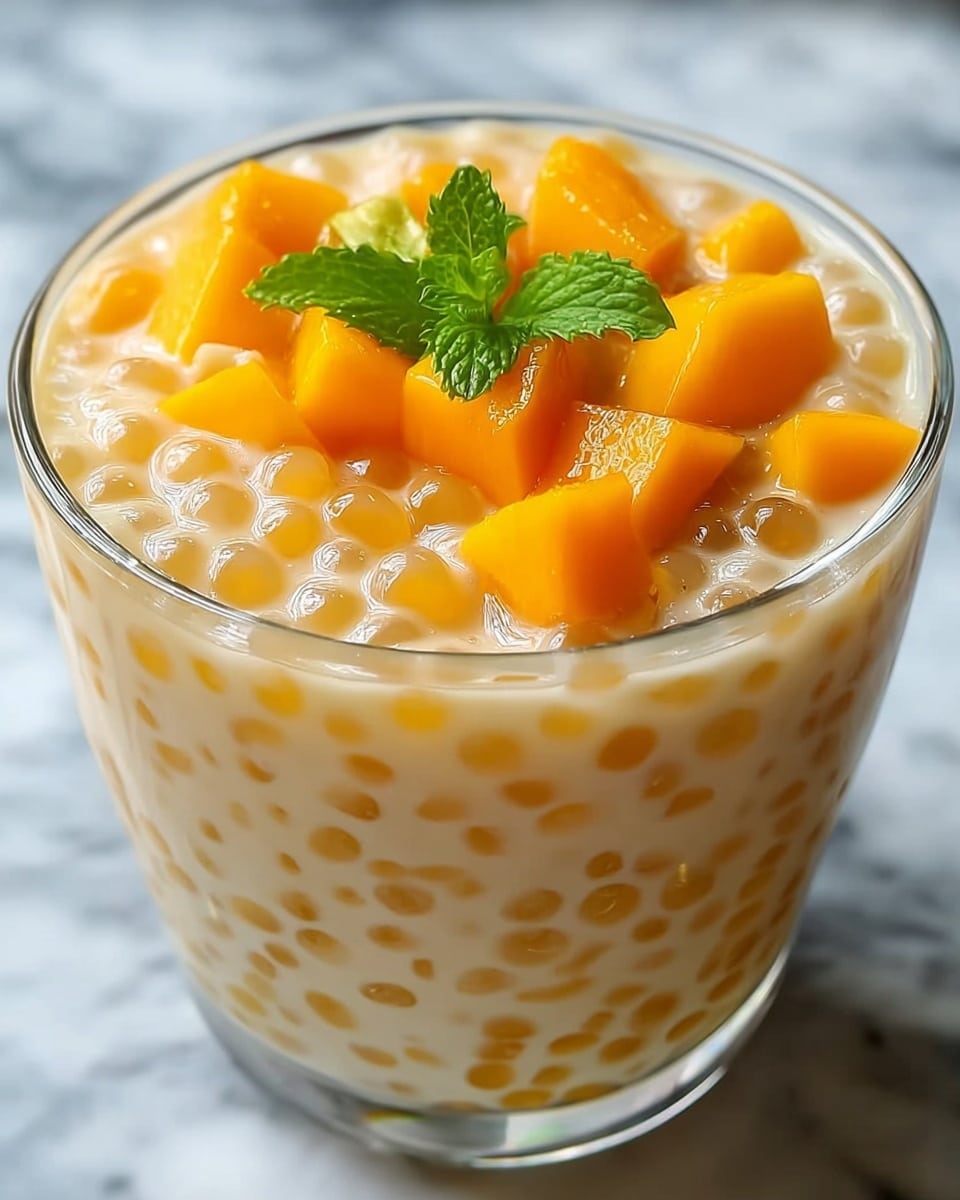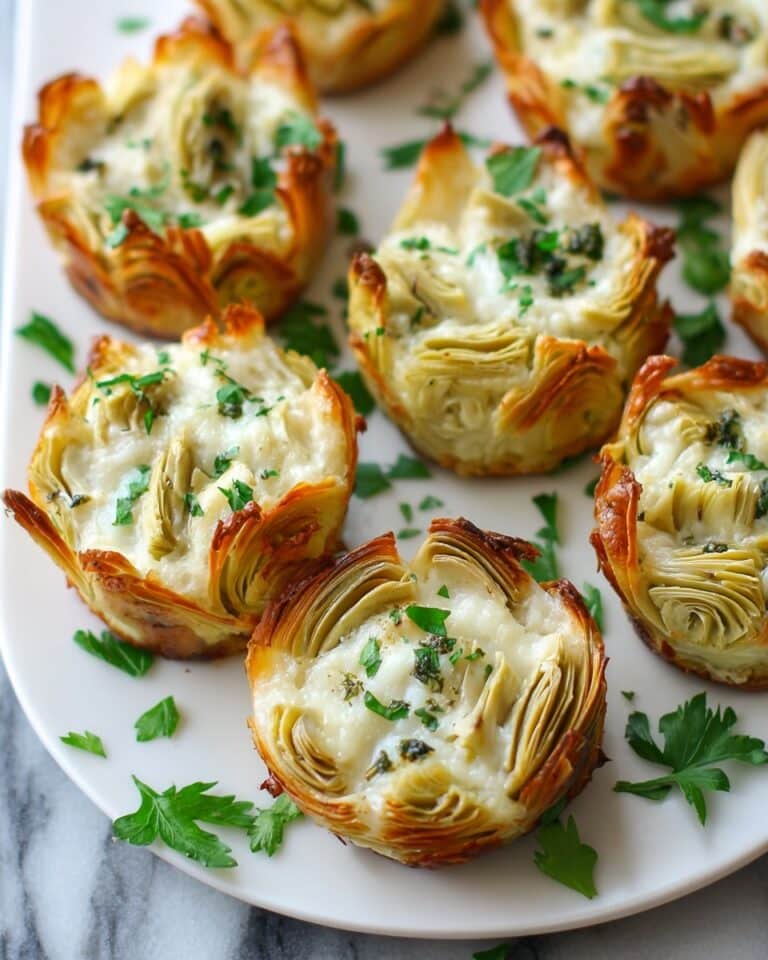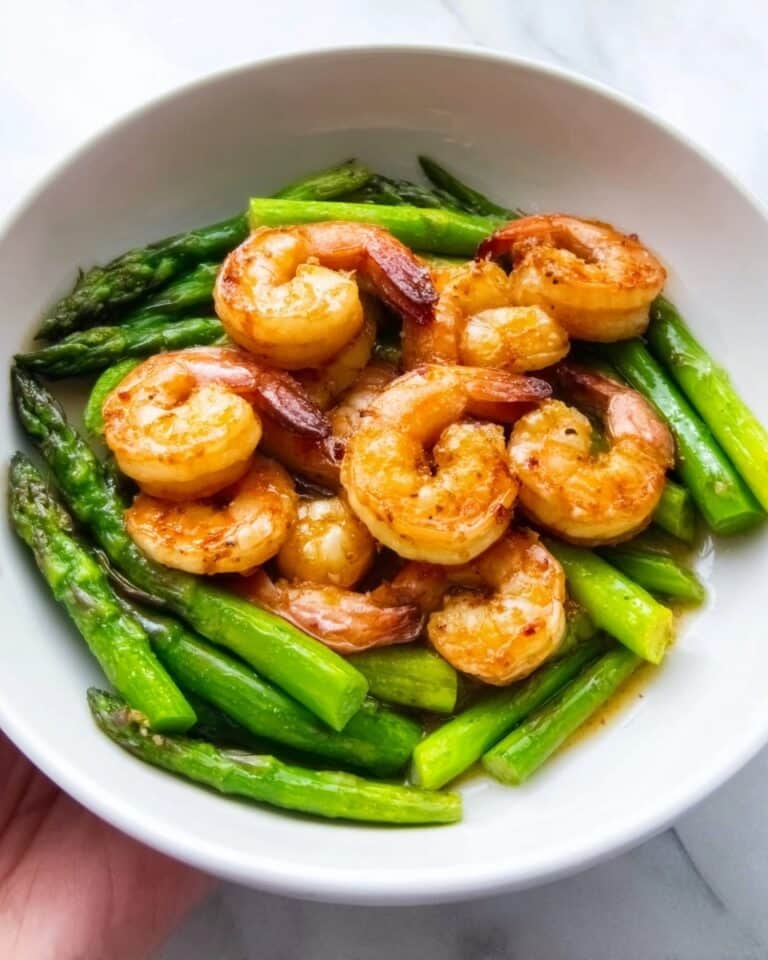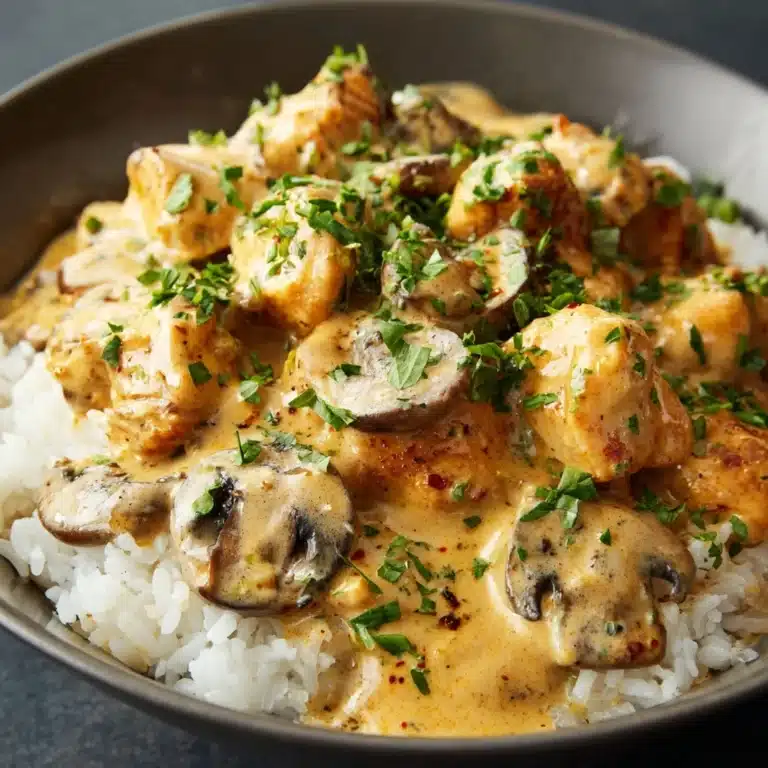If you’re craving a dessert that’s both refreshingly light and decadently creamy, look no further than this incredible Mango Sago Recipe. This delightful treat features luscious ripe mangoes paired perfectly with chewy tapioca pearls, all enveloped in a rich, velvety coconut and milk base. It’s a tropical hug in a bowl that’s simple to whip up yet impressively flavorful. Whether you’re treating yourself after a long day or serving guests at a gathering, this Mango Sago Recipe is sure to become a beloved favorite in your dessert repertoire.
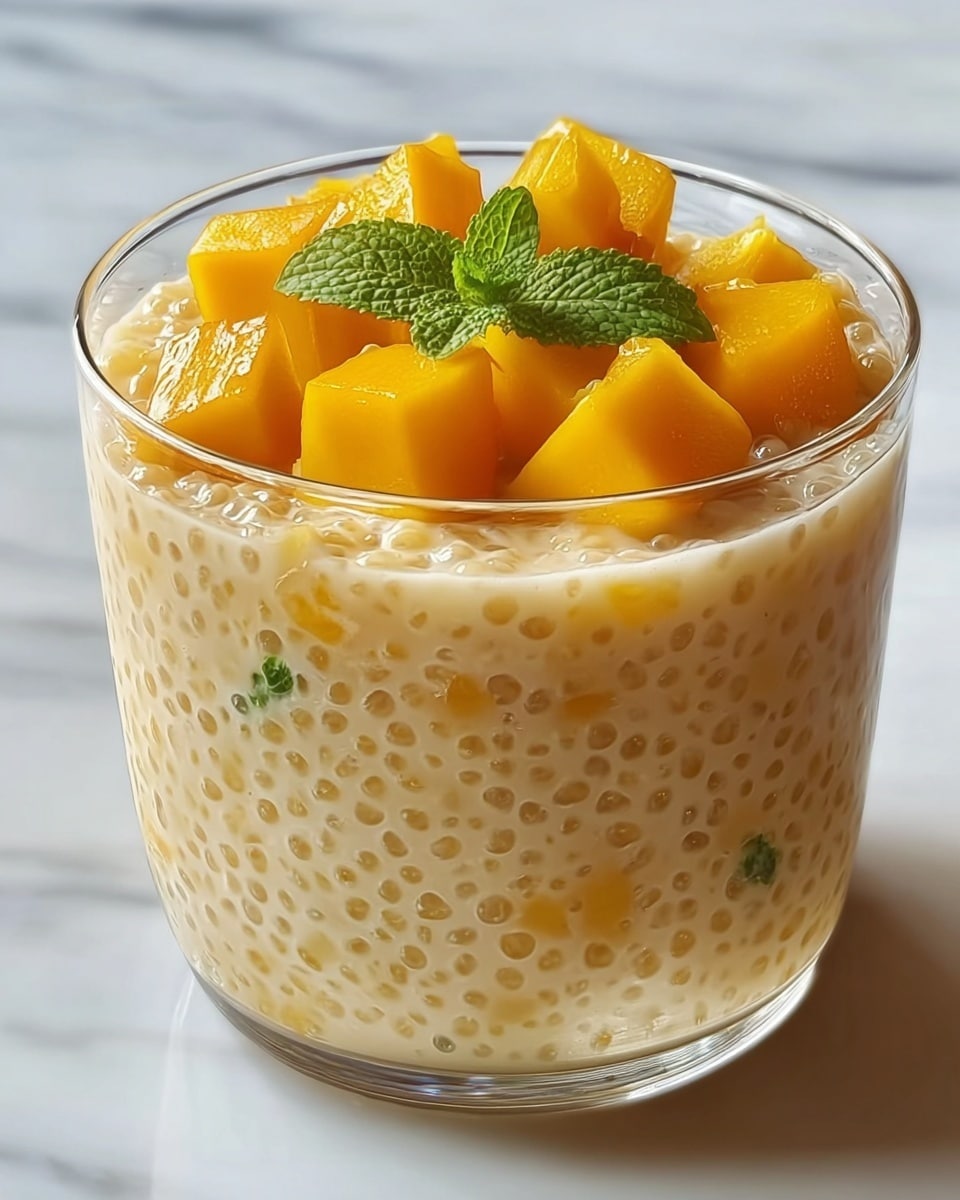
Ingredients You’ll Need
The beauty of this Mango Sago Recipe lies in its straightforward and well-balanced ingredients. Each one plays a key role, from the sweetness of the mangoes to the creamy texture brought by the combination of coconut milk and whole milk. Every addition enhances the overall taste and texture, making this dish irresistible.
- 2 ripe mangoes (peeled and diced): Choose fragrant, sweet mangoes for the best flavor and vibrant color.
- 1 cup small tapioca pearls (sago): These pearls add a pleasant chewiness that contrasts perfectly with the smooth mango custard.
- 1 cup coconut milk: Brings a luscious, tropical creaminess that’s essential to this dessert’s rich base.
- 1 cup whole milk (or evaporated milk): Adds smoothness and balances the coconut’s richness; evaporated milk makes it extra creamy.
- 1/4 cup sweetened condensed milk: The magic ingredient for natural sweetness and silky texture—adjust to your taste.
- 1/4 cup sugar (optional): Use only if your mangoes aren’t as sweet, so you can customize the sweetness perfect to your liking.
- 1/2 teaspoon vanilla extract (optional): Adds a subtle warmth and depth to the flavor.
- A pinch of salt: Enhances all the other flavors by balancing the sweetness.
- Ice cubes or crushed ice (for serving): Perfect for that rejuvenating chill on a warm day.
How to Make Mango Sago Recipe
Step 1: Prepare the Tapioca Pearls
Start by rinsing the tapioca pearls under cold water to wash away any excess starch. Boil a pot of water, then add the pearls and let them simmer for about 10 to 15 minutes, stirring occasionally so they don’t stick together. You’ll know they’re ready once they turn translucent. After turning off the heat, let them sit for another 5 minutes before draining and rinsing again under cold water to remove any excess stickiness. This step ensures you get pearls that are perfectly chewy but not mushy.
Step 2: Make the Mango Mixture
Next, put one of your diced mangoes in a blender along with the coconut milk, whole milk (or evaporated milk), and sweetened condensed milk. Blend until everything is super smooth and creamy. Take a moment to taste the mixture and decide if you want to add the optional sugar—it all depends on how sweet your mangoes naturally are. This creamy mango base is the heart of the Mango Sago Recipe, setting the tone for every delicious bite.
Step 3: Combine and Chill
Grab a large mixing bowl and combine your mango puree with the cooked tapioca pearls. Add the vanilla extract and a pinch of salt to bring all those flavors together beautifully. Gently fold in the second diced mango, giving the dessert lovely chunks of juicy fruit throughout. Once combined, cover the bowl and chill in the refrigerator for at least one hour. This chilling step lets the flavors marry wonderfully and creates an irresistibly cool, refreshing dessert.
How to Serve Mango Sago Recipe
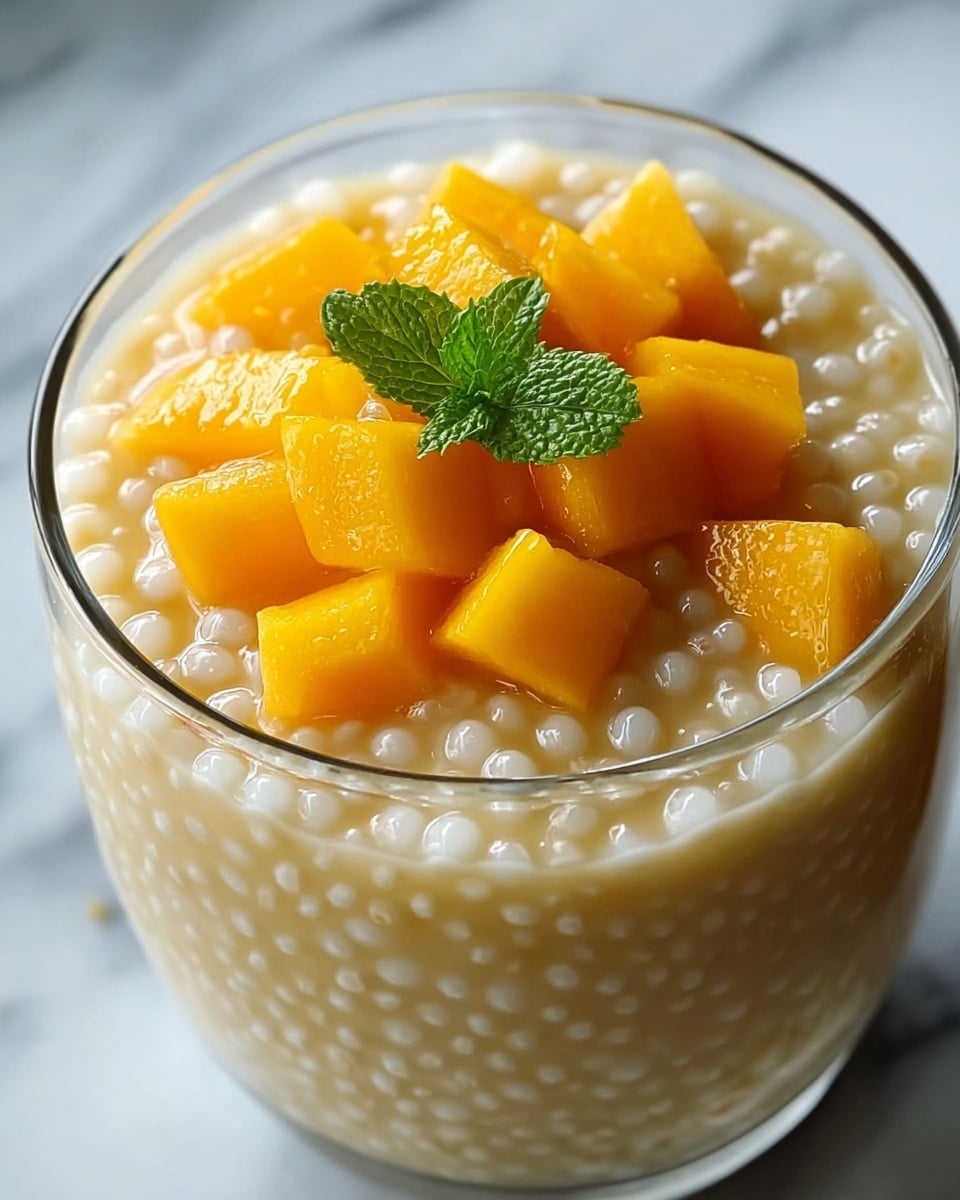
Garnishes
Serving your Mango Sago Recipe is the perfect opportunity to get creative and make it look as good as it tastes. Adding a few extra diced mango cubes on top instantly amps up the visual appeal and mango flavor. You can also sprinkle toasted coconut flakes for a subtle crunch and aroma or add fresh mint leaves for a pop of color and freshness.
Side Dishes
This dessert shines best as a light finish to a meal, so pair it with tropical or Asian-inspired dishes like grilled shrimp skewers, coconut curry, or even a refreshing green papaya salad. The creamy sweetness of mango sago balances beautifully with savory or spicy flavors, rounding off your meal with elegance and a smile.
Creative Ways to Present
If you want to elevate your Mango Sago Recipe, try serving it in individual clear glasses or pretty mason jars layered with crushed ice. For special occasions, you can even hollow out mini coconuts or mango halves and serve the dessert inside for that wow-factor presentation. These little touches make it feel extra special and fun to enjoy.
Make Ahead and Storage
Storing Leftovers
After enjoying your Mango Sago Recipe, any leftovers should be stored covered in the refrigerator. Keep it chilled to maintain the freshness and creamy consistency, and it’s best eaten within 1 to 2 days as the tapioca can continue to soften over time.
Freezing
Freezing this dessert is not recommended because the texture of the tapioca pearls can become unpleasantly hard or mushy once thawed. It’s best to enjoy your Mango Sago fresh or within a couple of days refrigerated.
Reheating
Since this dessert is meant to be served cold, reheating isn’t necessary. If you find the tapioca pearls a bit too thick after refrigeration, you can stir in a splash of milk or coconut milk to loosen the texture before serving.
FAQs
Can I use canned mango pulp instead of fresh mangoes?
Yes, canned mango pulp can be a convenient alternative if fresh mangoes are out of season, but fresh mangoes give a brighter and more vibrant flavor and texture that really elevates this Mango Sago Recipe.
Is tapioca the same as sago?
They are similar but not exactly the same. Tapioca pearls are derived from cassava starch, while sago pearls come from sago palm starch. For this recipe, small tapioca pearls are a great and more readily available substitute for traditional sago.
How can I make this dessert dairy-free?
You can make a dairy-free version by using coconut milk only and skipping the condensed milk or replacing it with a dairy-free condensed milk alternative or a little maple syrup for sweetness.
Why is my tapioca mixture too thick after chilling?
Tapioca pearls naturally thicken liquids as they soak, especially when chilled. Stirring in a bit more milk or coconut milk before serving helps achieve the ideal consistency.
Can I prepare Mango Sago Recipe ahead of time for a party?
Absolutely! Prepare it a few hours in advance and keep it chilled until serving. Just wait to add the ice or crushed ice until the last moment so it stays refreshingly cold without diluting the flavor.
Final Thoughts
The Mango Sago Recipe is a wonderful way to celebrate the freshness of ripe mangoes with a fun twist on texture and flavor. It’s easy to make, deeply satisfying, and perfect for warm days or anytime you want a taste of tropical magic in a bowl. Take a chance on this dessert—you’ll find yourself coming back for more with every spoonful!
Print
Mango Sago Recipe
- Total Time: 30 minutes (plus 1 hour chilling time)
- Yield: 4 servings 1x
- Diet: Vegetarian
Description
Mango Sago is a refreshing and creamy Asian dessert made with ripe mangoes, small tapioca pearls (sago), and a rich coconut-milk-based mixture. This easy-to-make Filipino favorite combines sweet mango puree with chewy tapioca for a delightful texture contrast, served chilled with ice cubes for the perfect tropical treat.
Ingredients
Ingredients
- 2 ripe mangoes, peeled and diced
- 1 cup small tapioca pearls (sago)
- 1 cup coconut milk
- 1 cup whole milk or evaporated milk
- 1/4 cup sweetened condensed milk (adjust to taste)
- 1/4 cup sugar (optional, adjust to sweetness of mangoes)
- 1/2 teaspoon vanilla extract (optional)
- Pinch of salt
- Ice cubes or crushed ice (for serving)
Instructions
- Cook the tapioca pearls: Rinse the tapioca pearls under cold water to remove excess starch. Bring a pot of water to a rolling boil, then add the pearls. Simmer for 10–15 minutes, stirring occasionally to prevent sticking, until the pearls become translucent.
- Rest and rinse the tapioca: Turn off the heat and let the cooked tapioca pearls sit in the hot water for another 5 minutes to fully cook through. Drain the pearls and rinse them under cold water to stop the cooking process and remove excess starch.
- Prepare the mango puree: In a blender, combine one peeled mango with coconut milk, whole milk (or evaporated milk), and sweetened condensed milk. Blend until smooth and creamy.
- Adjust sweetness: Taste the mango mixture and add sugar if needed, blending briefly to incorporate. This ensures the dessert matches your desired sweetness level.
- Combine ingredients: In a large mixing bowl, mix the mango puree with the cooked tapioca pearls. Add vanilla extract and a pinch of salt, then stir gently to combine evenly.
- Add diced mango: Dice the second mango into small pieces and fold them gently into the mixture, adding bursts of fresh mango flavor and texture.
- Chill and serve: Cover the bowl and chill in the refrigerator for at least 1 hour to allow the flavors to meld and the dessert to become cold and refreshing. Serve with ice cubes or crushed ice for added coolness.
Notes
- Use evaporated milk instead of whole milk for a richer and creamier texture.
- For a dairy-free version, substitute all milk with coconut milk and omit sweetened condensed milk.
- Fresh ripe mangoes yield the best flavor; canned mango pulp can be used if fresh mangoes are unavailable.
- Adjust sweetness according to the natural sweetness of your mangoes and personal preference.
- Serve immediately with ice for the best refreshing experience or store chilled for up to 1 day.
- Prep Time: 15 minutes
- Cook Time: 15 minutes
- Category: Dessert
- Method: Boiling
- Cuisine: Asian, Filipino
